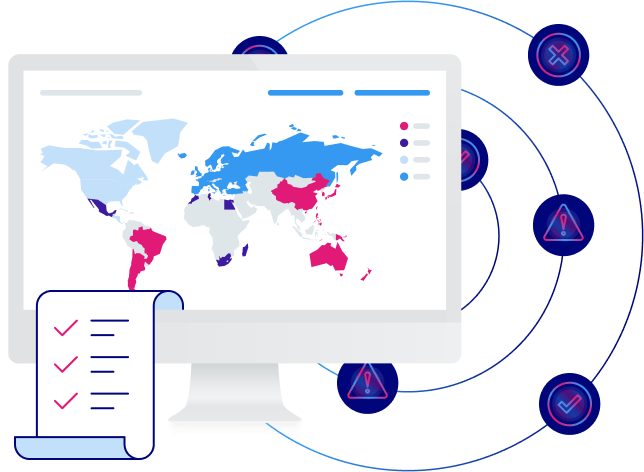-
Solutions
- AI Governance
- Geo-Specific Cookie Banner
- Consumer Preference Management
- Data Subject Request Automation
- Data Mapping and Vendor Risk Management
- Privacy, Vendor, and Risk Assessments
- Privacy Program Management
- Regulatory Guidance
- Privacy Program Consulting
- Certifications and Verifications
- International Data Transfers
Forrester TEI ROI of Privacy ReportTrustArc commissioned a Forrester study to analyze the potential benefits of using our platform and the Forrester team found ROI linked to efficiency, compliance, and decreased cost in data breaches.
Read the report -
Products Products Consent & Consumer Rights Overview
Experience automated privacy solutions that simplify compliance, minimize risk, and enhance customer trust across your digital landscape.
- Cookie Consent Manager Effortlessly manage cookie consent for global compliance, ensuring a secure, personalized browsing experience.
- Consent & Preference Manager Easily manage customer consent across brands and platforms—email, mobile, advertising—with a centralized repository.
- Individual Rights Manager Automate and streamline DSR workflows to ensure compliance and show your commitment to customer rights.
- Trust Center Quickly centralize, manage, and showcase all trust and safety information in an easily customizable, no-code hub.
Products Privacy & Data Governance OverviewSimplify privacy management. Stay ahead of regulations. Ensure data governance with cutting-edge solutions.
- PrivacyCentral Centralize privacy tasks, automate your program, and seamlessly align with laws and regulations.
- Data Inventory Hub & Risk Profile Gain full visibility and control of your data and accurately identify and mitigate risks.
- Assessment Manager Automate and score privacy assessments like PIAs and AI Risk, streamlining your compliance workflow.
- Nymity Research Get instant access to the latest in privacy regulations, legal summaries, and operational templates.
Products Assurance & Certifications OverviewBoost brand trust with TRUSTe's certifications, showing your privacy commitment with the most recognizable seal, assessed by unbiased experts.
- Dispute Resolution
- TRUSTe Enterprise Privacy Certification
- TRUSTe EDAA Privacy Certification
- TRUSTe APEC CBPR and PRP Certification
- TRUSTe Data Collection Certification
- CCPA/CPRA Validation
- Data Privacy Framework Verification
- GDPR Validation
- Digital Advertising Alliance Validation
- TRUSTe Responsible AI Certification
-
Regulations
- EU General Data Protection Regulation (GDPR)
- California Consumer Privacy Act (CCPA)
- Virginia Consumer Data Protection Act (CDPA)
- NIST AI Framework
- ISO/IEC 27001
EU Artificial Intelligence Act (EU AI Act)EU's regulation on the use of AI and the world's first comprehensive AI law.
Learn moreData Privacy Framework (DPF)Transatlantic data transfer mechanism for EU-U.S., UK, and Swiss-U.S. commerce.
Learn more - Resources
- Contact us
The National Institute of Standards and Technology (NIST) Cybersecurity Framework
The NIST Cybersecurity Framework 2.0 is a voluntary tool that provides organizations with industry best practices to improve organizational cybersecurity posture and resilience, and to enable organizations to consider cybersecurity risks as part of the organization’s risk management process.
Are you subject to the NIST Cybersecurity Framework?
The application of the NIST Cybersecurity Framework (CSF) is voluntary. Any organization – of varying sizes, level of cybersecurity risk or expertise, and industries – may apply the recommendations provided by the framework.
The CSF is particularly beneficial for individuals responsible for overseeing organizational cybersecurity programs and risk management activities and policies, including:
- Board of directors;
- Risk managers;
- Lawyers;
- Cybersecurity and risk management auditors; and
- Cybersecurity policy-makers and regulators.
Key requirements of the NIST CSF
CSF Organizational Profiles
The CSF Profile is a procedure to describe and assess an organization’s current and/or target cybersecurity posture based on its Core cybersecurity outcomes. Organizational Profile helps facilitate continuous improvement of organization’s cybersecurity that may be grounded in Current Profiles and/or Target Profiles, and steps can be taken to achieve this, including:
- Scoping the Organizational Profile;
- Gathering information (e.g. risk management policies) needed to prepare the Organizational Profile;
- Creating the Organizational Profile;
- Analyzing gaps between Current and Target Profiles;
Creating and implementing an action plan; and - Updating the Organizational Profile.
CSF Tiers
Tiers describe an organization’s benchmark for achieving a certain level of security governance and risk management robustness. There are four Tiers that organizations may strive to achieve, including:
- Tier 1 (partial);
- Tier 2 (risk-informed);
- Tier 3 (repeatable); and
- Tier 4 (adaptive).
CSF Core
The CSF Core establishes a set of predefined and broad cybersecurity outcomes to help organizations identify and breakdown desired cybersecurity goals intended to be achieved. Cybersecurity outcomes can be arranged by “Functions” – which includes: Govern, Identify, Protect, Detect, Respond, and Recover – and are further broken down into specific “Categories” of outcomes and “Subcategories”.

Mitigating Third-Party Risk: Best Practices for CISOs
Join us for an insightful and informative webinar as we delve into mitigating third-party risks. This webinar will provide essential strategies and best practices to ensure robust security and privacy measures when collaborating with external entities.
Achieve compliance
-
Privacy program development and compliance management Automatically identify gaps and track compliance with PrivacyCentral for NIST, ISO, and other privacy and security standards.
-
Guidance and operational templates Stay ahead of framework changes with expert guidance, ensuring your security and privacy practices remain compliant and up to date. Operationalize quickly with expert written operational templates for sample policies, checklists, and more.

The information provided does not, and is not intended to, constitute legal advice. Instead, all information, content, and materials presented are for general informational purposes only.




